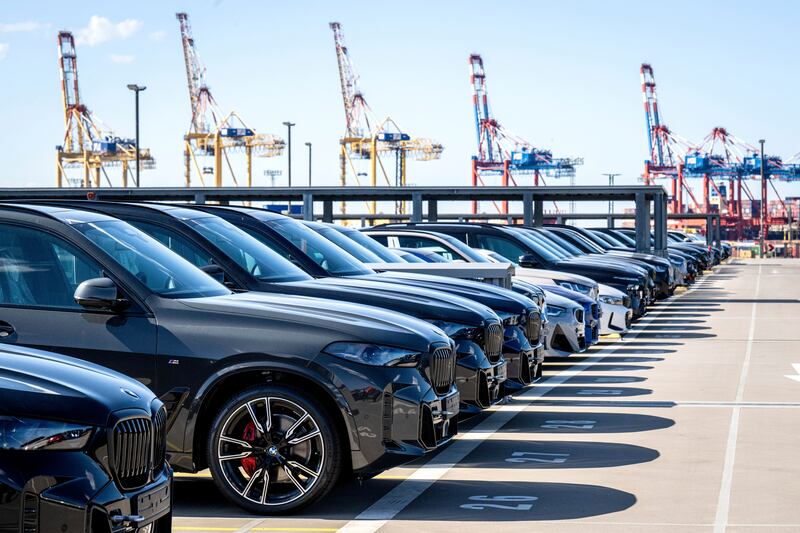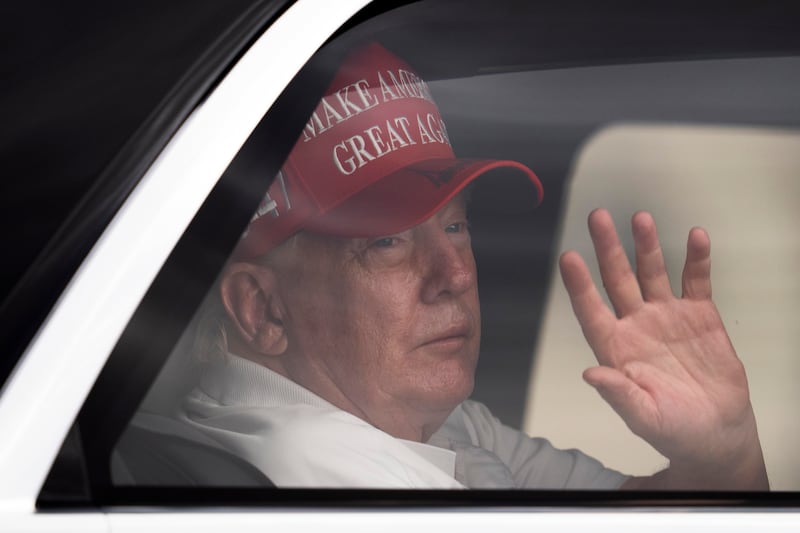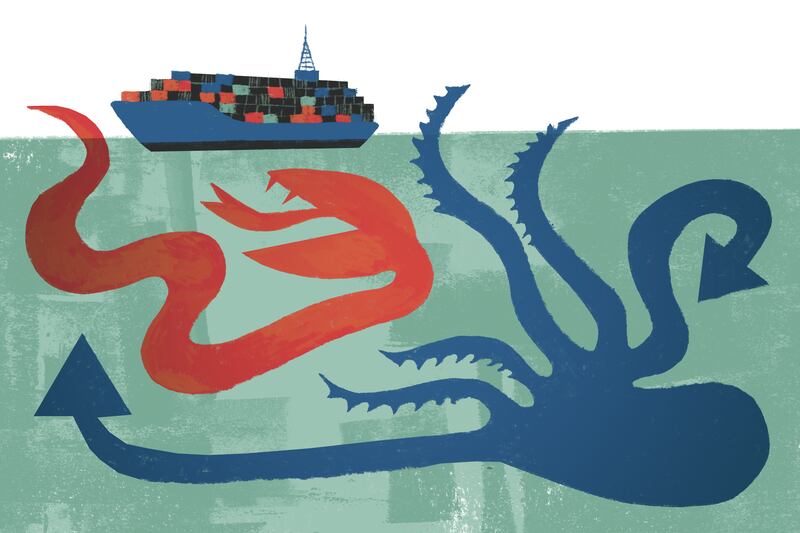- President Trump's list of tariffs include a 25% tax on car imports, 25% on steel and 10% on Chinese goods.
- Since Trump took office, the world's largest tech companies said they will invest in new U.S. factories.
- Over the last 30 years, China has replaced America as the world's dominant manufacturer.
President Donald Trump appears to be following through with his promise to remake American manufacturing — and the global economic order — with the announcement of an expansive tariff regime unlike anything the country has seen since 1930.
Wednesday marks the administration’s “Liberation Day,” with new tariffs of up to 25% expected on imports from at least a dozen trade partners, and potentially all countries. The sweeping change to United States trade policy follows a series of targeted tariffs announced since Trump entered office in January.
The list includes: 25% on most Canadian and Mexican goods, an additional 10% on all Chinese goods, 25% on all steel and aluminum imports and 25% on cars and car parts, with partial exceptions for automobiles that fall under the United States-Mexico-Canada Agreement.
Trump has also threatened industry-specific tariffs on copper, dairy, computer chips, lumber, oil, energy, alcohol and medicine.
Together, China, Japan and South Korea — and separately, Canada, Mexico and the European Union — have vowed to respond with reciprocal tariffs matching those from the Trump administration.

China has already implemented new 15% duties on U.S. agricultural imports and Canada has announced 25% tariffs on $30 billion in American products. The stock market has responded to the uncertainty of the international tit-for-tat by logging its worst quarter since 2022.
But amid the chaos, the Trump administration points to evidence that their plan to support American-made products is already working. Here are just a few examples from the past month:
- On March 20, the world’s biggest computer chipmaker, Nvidia, announced “several hundred billion” dollars in investments to build electronics in the U.S.
- On March 4, the world’s largest semiconductor foundry, TSMC, announced $100 billion in new investments to build three new fabrication plants, two package facilities and a research center in the U.S.
- On Feb. 24, the world’s most valuable company, Apple, announced $500 billion in investments to construct a new factory and hire 20,000 people in the U.S.
While the jury is still out on what the president’s economic overhaul will mean for American workers — or how long escalating trade tensions will last — there is no denying that Trump has single-handedly reignited the debate over tariffs.
Trump’s intellectual allies argue that tariffs are a blunt instrument to rebalance trade disparities and revive the American heartland. Meanwhile, a host of mainstream economists predict a parade of horribles, from rising prices to international isolation leading to a more dominant China.
Regardless of the answer, top thinkers on both sides of the question agree that America’s great tariff debate could determine if the “American Century” is reaching its end or is on the cusp of renewal.

Did tariffs make America great?
In the middle of Trump’s burgeoning trade war, Utah Gov. Spencer Cox is leading a trade mission to Canada next week to strengthen ties between Utah businesses and their Canadian counterparts in the fields of mineral extraction, finance and artificial intelligence.
During a televised press conference last month, Cox withheld judgment on the president’s trade policy, saying he had previously considered tariffs an antiquated and thoroughly debunked tool but that he was hopeful they would bring about the changes Trump has promised.
“I think it’s a huge gamble,” Cox said. “And we’ll see if it’s a little short-term harm for a long-term gain, or if this potentially sends us into a recession.”
Cox also mentioned Utah’s rocky relationship with tariffs. In 1930, the state’s senior U.S. senator, Reed Smoot, sponsored the now-infamous Smoot–Hawley Tariff Act, increasing tariffs on 20,000 imported goods. The law, and the retaliatory tariffs from U.S. trading partners, are widely viewed as having dramatically decreased trade and exacerbated the effects of the Great Depression.
But not all see Smoot–Hawley in the same light. Jeff Ferry, the chief economist emeritus at the Coalition for a Prosperous America, says Smoot’s law has been judged retroactively by those wanting to discredit tariffs. Ferry believes a proper understanding of tariffs must recognize how pivotal they were to America’s success and how their absence weakened the country.
“What we’ve seen in the last 50 years is a huge increase in inequality and the disappearance of millions of middle class jobs,” Ferry told the Deseret News. “The U.S. had high tariffs from 1816 until 1945 and that was the period in which we rose to become an industrial superpower and the wealthiest country in the world.”
According to Ferry, who authored an award-winning 2019 paper on decoupling America’s economy from China, the prevailing free-trade consensus has invited other countries to undermine American products and workers with their own state-subsidized alternatives and lower-wage workforces.
Tariffs have a proven track record of leveling the playing field to support important industries while also ensuring that the U.S. can catch up to China in computer, energy and military manufacturing, Ferry said.
But from a free-market point-of-view, Ferry’s diagnosis is mistaken and his prescription is misguided, according to Donald Boudreaux, a professor of economics at George Mason University. In fact, Boudreaux rejects Ferry’s framing entirely.
“There simply has been no hollowing out of the middle class or of industry,” Boudreaux told the Deseret News. “There is no evidence for it whatsoever.”
Not only are inflation-adjusted wages the highest they have ever been in U.S. history, Boudreaux pointed out, but in February the country broke its own record for industrial production.
Arguments in favor of tariffs tend to rely on a narrative of rescuing rust-belt America instead of looking at economic data, according to Boudreaux. While the U.S. did use tariffs for tax revenue before the income tax was implemented, the course of U.S. history reveals that industrial production increased more slowly during times with high tariff rates, and faster during times with low tariffs, Boudreaux said.
“The evidence shows that industrial growth went in an opposite direction to tariff growth,” Boudreaux said.

Can tariffs save the working class?
Scott Lincicome, the vice president of general economics at the libertarian Cato Institute, agrees that the evidence surrounding the impact of tariffs on the economy goes only one way.
But Lincicome takes his criticism one step further; he believes tariffs will have the exact opposite impact on the economy as Trump is promising.
As Trump’s Department of Government Efficiency seeks to cut bureaucratic red tape, global tariffs will explode regulatory complexity, Lincicome said. As Trump aims to increase the number of American factories, tariffs will spike costs for the 80% of manufacturers that import or export. As Trump works to bring down inflation, companies will pass on at least some of the tariff burden to consumers through higher prices.
“Tariffs are a tax,” Lincicome told the Deseret News. “Higher prices then trickle through the economy and they ultimately depress economic activity.”
While Ferry acknowledged that prices will rise in specific sectors on account of the tariffs, he said the first Trump term showed that nowhere near the full cost of the tariff is passed on through higher prices and that tariffs did not lead to persistent inflation.
Similarly, Mark DiPlacido, a trade policy advisor at American Compass, views temporary fluctuations in the market as minutiae compared to the large-scale problems plaguing America’s trade relationship with the rest of the world.
A massive deficit between how much America is buying from other countries and how much it is selling reveals “systemic” inequities that slowly bleed the country of high-wage working class positions and make innovation more difficult, DiPlacido said.
Since China overtook the U.S. as the world’s dominant manufacturing super power in 2010, it has claimed 32% of the global share of manufacturing, leaving the U.S. at No. 2, with 16% of the share. Before China joined the World Trade Organization in 2000 and gained Special Trading Status in 2001, that ratio was flipped, with the U.S. holding 23% of the global share of manufacturing and China having just 3%.
If nothing is done, projections put China’s share at 45% by 2040, with the United States falling to 11%, DiPlacido said, which could have dire national security implications as China already produces more than half of the world’s commercial ships and is leading out on battery technology and electric vehicles.
“So it’s not just low end manufacturing that we’re losing; it’s not just T-shirts,” DiPlacido said. “It’s things that are essential to the basic functioning of the 21st century economy.”
Is the US economy the best in the world?
Ultimately, America’s debate over tariffs comes down to current perceptions about the state of the U.S. economy.
Those who share Trump’s view that America has been perpetually ripped off by self-interested countries while U.S. policymakers promote free trade see tariffs as a muscular way the U.S. can reassert its power and retake lost jobs and stolen security.
But defenders of the status quo say America’s increased economic interconnectedness over the last 80 years has yielded lower prices, higher profits and better products for American consumers.
“The U.S. economy today is — until the latest tariff turmoil — the envy of the world," Lincicome said. “If you look at the list of the largest, most innovative companies in the world, most of them are in the United States.”
So why the apparent support among many, mostly Republican, elected officials and policy experts? According to Lincicome, it comes down to four factors: (1) a persistent populist backlash to the 2008 Great Recession, (2) the rapid rise of China as an economic and military competitor, (3) a distrust of global supply chains sparked by the COVID-19 pandemic and (4) the influence of Trump over his party.
While Trump may have injected political action into the debate around tariffs, Ferry is convinced that the sentiment had been growing among U.S. citizens all along. A return to protectionist tariff policies was almost inevitable, Ferry said, as American workers saw factories shutter, corporations ship jobs overseas and American competitiveness wane.
“Populism is the phenomenon of people in the middle of the country seeing that globalization is bad for them,” Ferry said. “So because of democracy, we’re seeing a rejection of globalization and a move to something else, and tariffs are one part of the solution.”


